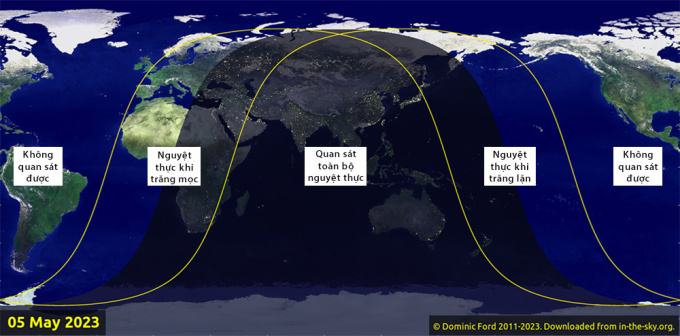The Moon will enter Earth's outer shadow on May 5, creating a penumbral lunar eclipse, making the Moon appear dimmer but not disappear.

Map showing areas where the lunar eclipse will be visible on May 5. Photo: Dominic Ford/In-The-Sky.org
The penumbral lunar eclipse will begin at 10:15 p.m. on May 5 ( Hanoi time) and can be observed from anywhere the Moon is above the horizon, including Antarctica, Asia, Russia, Oceania, and East and Central Africa. The event will peak at 0:24 a.m. on May 6 and end at 2:32 a.m. the same day, when the Moon exits the Earth's shadow.
Like all lunar eclipses, a penumbral lunar eclipse occurs when the Earth passes between the Moon and the Sun. This causes the Earth to block the light from the Sun and cast a shadow on the Moon.
A penumbral lunar eclipse occurs when the Moon enters the brighter outer region of Earth’s shadow, called the penumbra. This is the area where Earth appears to cover some of the Sun’s disk, but not all of it. When the Moon is in the penumbra, it receives less light from the Sun. To observers on Earth, the Moon appears darker but does not disappear completely.
This effect can be subtle and is sometimes only seen in detailed photographs or by people with extremely sharp eyesight. However, there are occasional events where the entire Moon moves into the penumbra. These rare eclipses cause more darkness and are more easily seen with the naked eye. Such events are called total penumbral lunar eclipses and are rare because once the Moon moves into the penumbra, it is more likely that at least part of the Moon will reach the umbra – the darker inner part of the Earth’s shadow. This creates a partial lunar eclipse rather than a penumbral eclipse.
Thu Thao (According to Space )
Source link
























































![[Maritime News] Container shipping faces overcapacity that will last until 2028](https://vphoto.vietnam.vn/thumb/402x226/vietnam/resource/IMAGE/2025/7/30/6d35cbc6b0f643fd97f8aa2e9bc87aea)













































Comment (0)